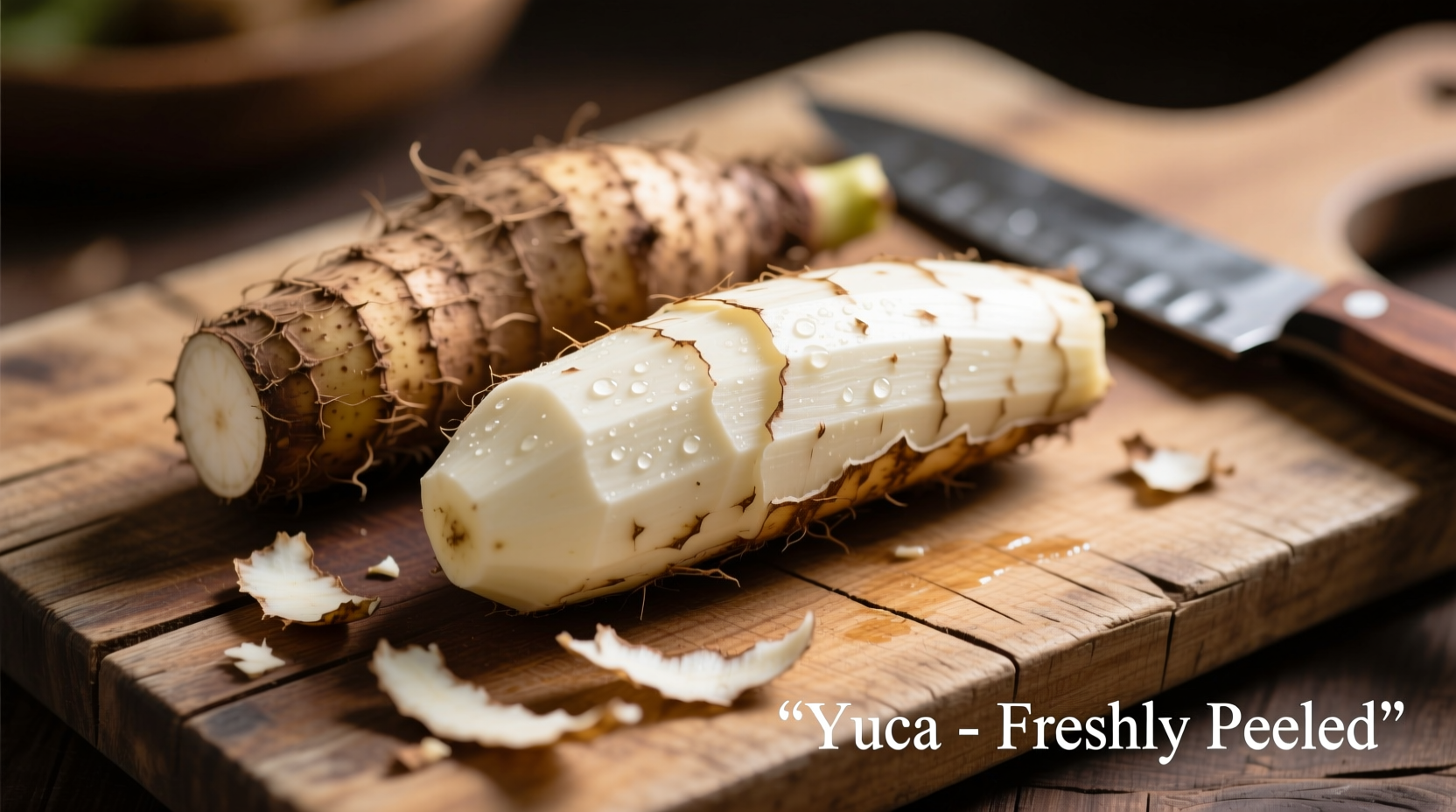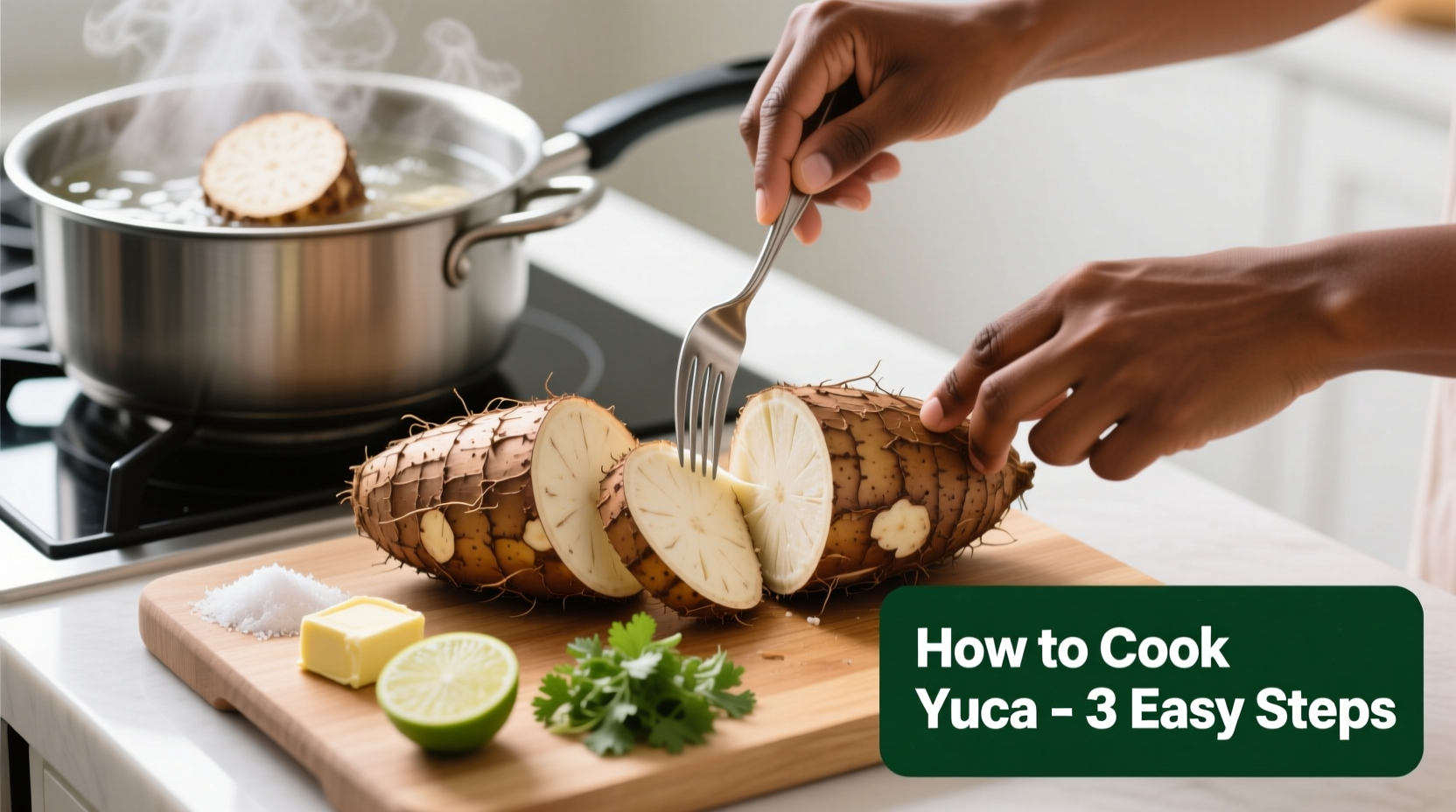Learn how to safely prepare and cook yuca (cassava) with this comprehensive guide. Proper preparation removes naturally occurring cyanogenic glycosides, making yuca safe to eat. Peel thick skin, remove fibrous core, and boil for at least 20 minutes or until fork-tender for perfect results every time.
Yuca, also known as cassava, is a starchy root vegetable that serves as a dietary staple for over 800 million people worldwide. When prepared correctly, it transforms from potentially toxic raw material into a delicious, versatile ingredient perfect for boiling, frying, or baking. This guide provides everything you need to safely and successfully cook yuca at home.
Selecting the Perfect Yuca
Choosing quality yuca is your first step toward delicious results. Look for firm roots with minimal cracks or soft spots. The best yuca feels heavy for its size and has a cylindrical shape with tapered ends. Avoid specimens with dark spots, mold, or excessive moisture on the surface, which indicate spoilage.
At the market, you'll typically find two varieties:
- Sweet yuca - Lower in cyanogenic compounds, often used in desserts
- Bitter yuca - Higher in natural toxins, requires more thorough preparation, common for savory dishes
| Yuca Selection Guide | What to Look For | What to Avoid |
|---|---|---|
| Appearance | Firm, cylindrical shape, brown outer skin | Cracks, mold, soft spots, green patches |
| Weight | Heavy for size (indicates freshness) | Lightweight (may be dried out) |
| Interior | Creamy white flesh when cut | Grayish or yellowish discoloration |
Safe Preparation: The Critical First Step
Yuca contains naturally occurring cyanogenic glycosides that must be properly processed to make it safe for consumption. According to research from the University of Florida's Institute of Food and Agricultural Sciences, proper preparation reduces cyanide content by up to 95%.
Follow these safety-focused preparation steps:
- Wash thoroughly under running water to remove dirt
- Cut both ends and make a lengthwise slit through the thick brown skin
- Peel carefully using a sharp knife, removing all brown skin and fibrous layer
- Remove the fibrous core running through the center (it won't soften during cooking)
- Cut into uniform pieces (2-3 inch chunks work best)
- Immediately submerge in cold water to prevent oxidation
Never skip the soaking step—this helps draw out additional toxins. For extra safety with bitter varieties, some traditional preparation methods include fermenting or sun-drying before cooking, but boiling alone is sufficient for most commercially available yuca.

Perfect Cooking Methods
Once properly prepared, yuca can be cooked using several methods. Each technique yields different textures and flavors suitable for various dishes.
Boiling Yuca (The Essential Foundation)
Boiling is the most important cooking method for yuca as it ensures safety by removing remaining toxins. This basic technique serves as the foundation for many other preparations.
Step-by-step boiling instructions:
- Place prepared yuca pieces in a large pot
- Cover with cold water by 1 inch
- Add 1-2 teaspoons of salt
- Bring to a rolling boil over high heat
- Reduce heat to maintain a gentle simmer
- Cook for 20-30 minutes until fork-tender
- Drain thoroughly before using
According to USDA food safety guidelines, boiling for at least 20 minutes is necessary to reduce cyanogenic compounds to safe levels. Test for doneness by inserting a fork—if it slides in easily with no resistance, your yuca is ready.
Yuca Fries: Crispy Perfection
Yuca fries offer a delicious alternative to traditional potato fries with their unique texture and subtle sweetness.
Method:
- Boil yuca pieces until just tender (about 15 minutes)
- Cool completely (refrigerate for 1 hour for best results)
- Cut into fry-shaped pieces
- Heat oil to 325°F (163°C)
- Fry in batches for 4-5 minutes until golden
- Drain on paper towels and season immediately
For authentic Latin American yuca fries, try adding a pinch of achiote powder to the oil for that distinctive golden color and earthy flavor.
Traditional Yuca Dishes to Try
With its neutral flavor and versatile texture, yuca adapts beautifully to numerous culinary applications across different cultures.
Yuca al Mojo (Cuban Style)
This classic Cuban preparation features boiled yuca served with a garlic-citrus sauce.
Simple recipe:
- Boil yuca until tender
- Prepare mojo sauce: 1/4 cup olive oil, 6 minced garlic cloves, 1/2 cup orange juice, 1/4 cup lime juice, salt to taste
- Heat oil, add garlic until fragrant (don't brown)
- Add citrus juices and heat through
- Pour sauce over drained yuca and serve
Cassava Cake (Filipino Dessert)
A sweet application showcasing yuca's versatility beyond savory dishes.
Basic preparation:
- Grate cooked yuca or process boiled pieces until smooth
- Mix with 1 can coconut milk, 1 cup sugar, 4 eggs, and 1/2 cup butter
- Pour into greased baking dish
- Bake at 350°F (175°C) for 45-55 minutes
- Cool completely before serving
Storage and Safety Tips
Proper storage extends yuca's shelf life and maintains quality:
- Unpeeled yuca keeps for 1-2 weeks in a cool, dark place
- Peeled yuca must be submerged in water in the refrigerator (change water daily) for up to 5 days
- Cooked yuca stores in airtight containers for 3-5 days in the refrigerator
- Freezing cooked yuca extends shelf life to 6 months (blanch before freezing)
Always remember: never eat raw yuca. The naturally occurring cyanogenic glycosides can cause cyanide poisoning when consumed in sufficient quantities. Proper cooking eliminates this risk completely.
Nutritional Benefits of Yuca
Beyond its culinary versatility, yuca offers impressive nutritional benefits. According to USDA nutritional data, one cup of cooked yuca provides:
- Approximately 330 calories
- 78 grams of carbohydrates
- 3 grams of dietary fiber
- 2.8 grams of protein
- Significant amounts of vitamin C, calcium, and potassium
Compared to potatoes, yuca contains more protein and calcium while being naturally gluten-free. Its high carbohydrate content makes it an excellent energy source, particularly valued in traditional diets across tropical regions.
Troubleshooting Common Yuca Problems
Even experienced cooks encounter issues with yuca preparation. Here's how to solve common problems:
- Yuca remains hard after boiling - You likely didn't remove the fibrous core completely. Always cut lengthwise to remove the central string.
- Bitter taste after cooking - The yuca may be a bitter variety that requires longer cooking or additional preparation steps.
- Yuca turns gray during cooking - This indicates oxidation. Always keep cut pieces submerged in water until ready to cook.
- Fries aren't crispy - Yuca must be cooled completely after boiling before frying. Moisture is the enemy of crispiness.
Yuca in Global Cuisines
Yuca's journey from its South American origins has made it a culinary staple across multiple continents. Anthropological research shows that indigenous peoples in the Amazon basin first domesticated yuca over 10,000 years ago. Today, it appears in diverse forms:
- Caribbean - As hearty side dishes like mofongo (mashed yuca with garlic and pork cracklings)
- African - In fufu (pounded yuca dough served with soups)
- Asian - As desserts like Filipino cassava cake
- South American - In traditional breads and beverages
Understanding these cultural contexts enriches your cooking experience and helps you appreciate yuca's significance beyond just another root vegetable.











 浙公网安备
33010002000092号
浙公网安备
33010002000092号 浙B2-20120091-4
浙B2-20120091-4